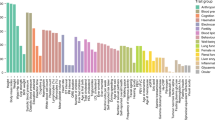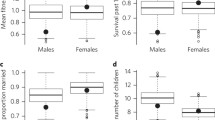Summary
The high incidence of the fra (X) syndrome (about 1∶2000 male newborns) requires an explanation in view of the low fitness of mentally retarded hemizygous males and heterozygous females. In the past, it has been proposed that the mutation rate may be unusually high, and that mutations occur exclusively in male germ cells. According to an alternative hypothesis, a moderately high mutation rate might combine with a selective advantage of clinically unaffected heterozygotes. In earlier studies, such a combined hypothesis was shown to lead to plausible implications regarding mutation rate and fitness. Moreover, a mutation rate in male germ cells of the magnitude required by the exclusive mutation hypothesis was excluded by studies on comprehensive pedigree data. In this third study in the series, an increased fitness of heterozygous females is demonstrated directly by a comparison of the reproductive performance of heterozygotes with that of adequate controls (mothers and grandparents of Down's syndrome patients). Since average numbers of children have decreased during recent decades in populations of industrialized countries, heterozygotes (mothers of affected probands and their female relatives in their own generation) were subdivided into those born before and after 1940. Moreover, sibship sizes of probands' mothers and fathers were analyzed separately for family branches in which the fra (X) trait segregated (mostly the maternal branch), or did not segregate (in most instances the paternal branch). In all four categories reproductive performance in heterozygotes was found to be higher than in the controls. This difference was significant statistically for two of the four groups: it was small and nonsignificant only for the parental family branch in which the fra (X) mutant did not segregate and for mothers born after 1940. Fitness estimates ranged between 1.11 and 1.36. A higher incidence of dizygotic twinning suggests a biological component for this increased fertility. On the other hand, fra (X) families have a significantly lower social status than the controls. This suggests a socio-psychological component of their higher fertility. Apparently, both components contribute to their fertility: at present, their relative importance cannot be assessed.
Similar content being viewed by others
References
Fryns JP (1986) The female and the fragile X. A study of 144 obligate female carriers. Am J Med Genet 23:157–169
Haldane JBS (1935) The rate of spontaneous mutation of a human gene. J Genet 31:317–326
Herbst DS, Miller JR (1980) Nonspecific X-linked mental retardation 11: the frequency in British Columbia. Am J Med Genet 7:461–469
Krüger J, Propping P (1976) Rückgang der Zwillingsgeburten in Deutschland. Dtsch Med Wochenschr 101:475–480
Laird CD (1987) Proposed mechanism of inheritance and expression of the human fragile X-syndrome of mental retardation. Genetics 117:587–599
Laird CD, Jaffe E, Karpen G, Lamb M, Nelson R (1987) Fragile sites in human chromosomes as regions of late-replicating DNA. Trends Genet 3:274–281
Müller KV (1956) Empirische Beiträge zur Frage der differentiellen Fruchtbarkeit im Nachkriegsdeutschland. Homo 7:87–110
Paul J, Froster-Iskenius U, Moje W, Schwinger E (1984) Heterozygous female carriers of the marker-X-chromosome: I. Q. testimation and replication status of fra (X)q. Hum Genet 66:344–346
Pembrey ME, Winter RM, Davies KE (1985) A premutation that generates a defect at crossing over explains the inheritance of fragile (X) mental retardation. Am J Med Genet 21:709–717
Penrose LS (1963) Outline of human genetics, 2nd edn. Heine-Mann, London
Propping P, Krüger J (1976) Über die Häufigkeit von Zwillingsgeburten. Dtsch Med Wochenschr 101:506–512
Reiss AL, Freund L, Vinogradov S, Hagerman R, Cronister A (1989) Parental inheritance and psychological disability in fragile X females. Am J Hum Genet 45:697–705
Seemanova E, Kovarik J, Subrt I, Steinbicker V, Goetz P, Houstek J, Nosek M, Chyleova L, Lippert P, Schmidt A, Jungmannova C (1987) Ultraschalluntersuchung der Ovarien bei Carriern für fra (X) und bei geistig behinderten Mädchen nach der Menarche (abstract), 20. Tagung der Gesellschaft für Anthropologie und Humangenetik, Giessen 1987. p 113
Seemanova E, Steinbicker V, Huistek J (1989) tSyndrom des fra (X): Ergebnisse einer Phänotypenanalyse bei obligaten und möglichen Carriern (in press)
Seemanova E, Steinbicker V, Kovarik J (1990) (in Czech). Cesk Pediatr (in press)
Sherman SL, Morton NE, Jacobs PA, Turner G (1984) The marker (X) syndrome: a cytogenetic and genetic analysis. Ann Hum Genet 48:21–37
Sherman SL, Jacobs PA, Morton NE, Froster-Iskenius U, Howard-Peebles PN, Nielsen KB, Partington MW, Sutherland GR, Turner G, Watson M (1985) Further segregation analysis of the fragile (X) syndrome with special reference to transmitting males. Hum Genet 69:289–299
Siegel S (1956) Nonparametric statistics for the behavioral sciences. McGraw-Hill, New York
Steinbach P (1986) Mental impairment in Martin-Bell syndrome is probably determined by interaction of several genes: simple explanation of phenotypic differences between unaffected and affected males with the same X chromosome. Hum Genet 72:248–252
Sutherland GR (1982) Heritable fragile sites of human chromoSomes, VIII. Preliminary population cytogenetic data on the folic-acid-sensitive sites. Am J Hum Genet 34:452–458
Sutherland GR (1985) Heritable fragile sites on human chromosomes, XII. Population cytosenetics. Ann Hum Genet 49:153–161
Turner G, Jacobs P (1983) Marker (X)-linked mental retardation. Adv Hum Genet 13:83–112
Vogel F (1977) A probable sex difference in some mutation rates. Am J Hum Genet 29:312–319
Vogel F (1984) Mutation and selection in the marker (X) syndrome. Ann Hum Genet 48:327–332
Vogel F, Motulsky AG (1986) Human genetics — problems and Approaches, 2nd edn, Springer, Berlin Heidelberg New York
Vogel F, Rathenberg R (1975) Spontaneous mutation in man. Adv Hum Genet 5:223–318
Vogel F, Krüger J, Brondum Nielsen K, Fryns JP, Schindler D, Schinzel A, Schmidt A, Schwinger E (1985) Recurrent mutation pressure does not explain the prevalence of the marker (X) syndrome. Hum Genet 71:1–6
Webb T (1989) The epidemiology of the fragile (X) syndrome. In: Davies KE (ed) The fragile (X) syndrome. Oxford University Press. Oxford New York Tokyo, pp 40–55
Weinberg W (1902) Beiträge zur Physiologie und Pathologie der Mehrlingsgeburten beim Menschen und Probleme der Mehrlingsgeburtenstatistik. Z Geburtshilfe Gynäkol 47:12
Weinberg W (1909) Der Einfluß von Alter und Geburtenzahl der Mutter auf die Häufigkeit der einund zweieiigen Zwillingsgeburten. Z Geburtshilfe Gynäkol 65:318–324
Author information
Authors and Affiliations
Rights and permissions
About this article
Cite this article
Vogel, F., Crusio, W.E., Kovac, C. et al. Selective advantage of fra (X) heterozygotes. Hum Genet 86, 25–32 (1990). https://doi.org/10.1007/BF00205167
Received:
Revised:
Issue Date:
DOI: https://doi.org/10.1007/BF00205167




